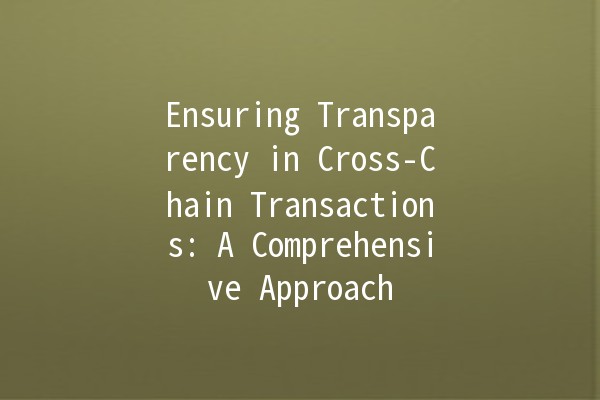
Understanding CrossChain Transactions
Crosschain transactions are essential for the evolving landscape of blockchain technology. They allow assets and data to be transferred between different blockchains, promoting interoperability in decentralized finance (DeFi), NonFungible Tokens (NFTs), and other blockchain applications. However, ensuring transparency in these transactions is crucial to build trust among users and maintain the integrity of the platforms involved.
In this article, we will explore effective strategies for enhancing transparency in crosschain transactions. We will present actionable tips to contribute to higher transparency and user trust, ensuring a seamless and secure experience.
Why Transparency Matters in CrossChain Transactions
Transparency plays a pivotal role in establishing confidence in blockchain transactions. When users can see the transaction history, the flow of assets, and know that the process is immutable, they are more likely to engage with the system. In crosschain transactions, the complexity increases, making transparency even more vital due to several factors:

Effective Strategies for Enhancing Transparency
Decentralized oracles can provide verified, realtime data from outside blockchains to smart contracts. This data is invaluable in crosschain transactions as it helps in ensuring that all parties have access to the same information, reducing the chances of fraud.
Application Example: Chainlink is a network of decentralized oracles that can facilitate crosschain transactions by providing reliable data feeds for any blockchainbased application. By integrating Chainlink, developers can ensure that their smart contracts receive trustworthy data.
Creating a comprehensive audit trail for every transaction is vital in enhancing transparency. An audit trail logs every action taken during the transaction process, which can be reviewed by users at any point.
Application Example: Platforms like Aave and Compound deploy mechanisms that allow users to track their transaction history through blockchain explorers. This feature enables users to verify the status of their transactions onchain, ensuring accountability and transparency.
An intuitive user interface that conveys detailed information about crosschain transactions can significantly impact user experience. Including transaction details, such as fees, timeframes, and status updates, can empower users with clear insights.
Application Example: Many DeFi platforms, like Uniswap, provide comprehensive dashboards that display crucial information related to transactions. By expanding on this idea, platforms can enhance transparency further by integrating realtime updates on the status of crosschain transactions directly in the user interface.
Multisignature (multisig) wallets require multiple private keys to authorize transactions, increasing security and transparency. This approach ensures that no single entity has complete control over the transactions, fostering a collaborative auditing process.
Application Example: Platforms like Bitgo and Gnosis offer multisig wallets that are increasingly used in DeFi projects. Utilizing these wallets for crosschain transactions assures users that these transactions are thoroughly vetted and approved by multiple parties before execution.
Encouraging community participation through feedback mechanisms can help in identifying and addressing transparency issues swiftly. Platforms can use forums, surveys, and user polls to better understand user concerns and improve accountability.
Application Example: Many DeFi projects actively involve their communities in decisionmaking processes through platforms like Discord or Telegram. By integrating community feedback into development cycles, these projects can enhance user trust and ensure better transparency in crosschain transactions.
Implementing these strategies will significantly contribute to the transparency of crosschain transactions. By utilizing decentralized oracles, creating detailed audit trails, enhancing user interfaces, employing multisig wallets, and encouraging community feedback, platforms can foster a trustworthy environment for users.
As blockchain technology continues to evolve, transparency will become an increasingly vital component in maintaining the integrity of crosschain transactions. By prioritizing these practices, we can build a more secure and userfriendly blockchain experience for everyone involved.
Frequently Asked Questions
Crosschain transactions allow the transfer of assets or data between different blockchain networks. Unlike traditional transactions that occur within a single blockchain, crosschain transactions can connect various protocols, enabling users to utilize styles and features from multiple ecosystems.
Transparency directly contributes to user trust by promoting accountability. If users can verify their transaction histories and feel secure in the processes involved, they are more likely to engage positively with the platform, thereby increasing overall adoption rates.
Decentralized oracles are thirdparty services that provide realtime data from the outside world to smart contracts on the blockchain. By using decentralized sources, these oracles ensure that the data is accurate and reliable, reducing the chance of manipulation and enhancing transparency.
Audit trails provide a chronological log of every action taken during a transaction process. This visibility helps track down any discrepancies, offers reassurance to users, and allows for regulatory compliance. An inherent feature of blockchain technology is that it is immutable, making these audit trails trustworthy.
Multisig wallets require multiple approvals for transactions, providing a layer of scrutiny and security. This process encourages collective accountability, as no single actor can unilaterally decide to execute a transaction, thus fostering more transparent practices in managing assets.
Users can participate in community forums, surveys, or dedicated feedback channels provided by platforms. Engaging with the community facilitates ongoing dialogue about transparency concerns, allowing platforms to respond to user needs effectively and build a culture of accountability.
By implementing these strategies, blockchain platforms can enhance transparency and ensure that crosschain transactions operate smoothly and securely, ultimately leading to a healthier ecosystem.

